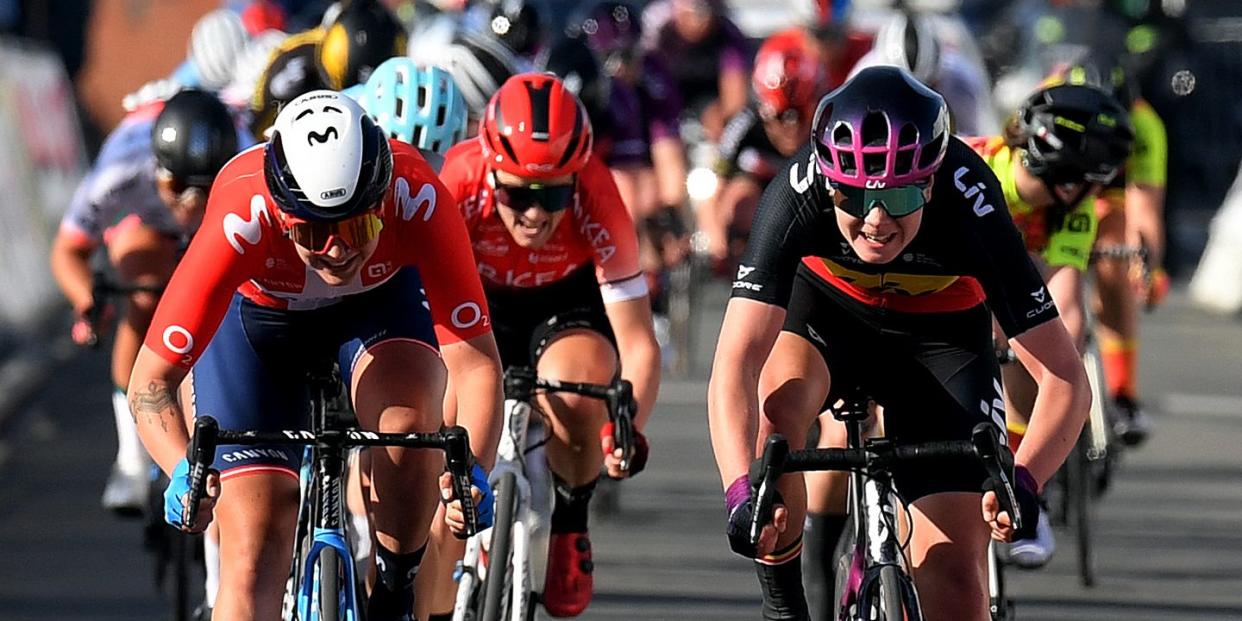Want to Avoid Sprint-Induced Nausea? Then You Need to Sprint More

Research published in Medicine & Science in Sports & Exercise shows that feeling nauseous and vomiting after performing max sprints is partially due to lactic acidosis—a state where your blood becomes more acidic than your body can handle.
The best way to avoid sprint-induced nausea: do more sprint training, which leads to adaptations that help your body experience less lactic acidosis.
Even if you feel sick after a full-throttle sprint, your performance on the next sprint won’t suffer if you have at least 20 minutes of easy pedaling to recover, say the researchers.
The first time I did a Wingate test (a 30-second all-out sprint test to determine your peak anaerobic power), the lab tech put a bucket on the floor next to me—you know, just in case. After the test, my leg muscles were searing, but my stomach thankfully stayed settled. But that’s not always the case when athletes go full throttle.
Tossing your energy bars (or coming darn close) is a common occurrence during max intensity efforts, but the reason why sprinting can make your stomach turn has been a bit of a mystery. Researchers say nausea associated with extreme exercise conditions is likely one of the many warning signals from your body—along with pain and fatigue—telling you to knock it off before you do some damage.
Sign up for Bicycling All Access for the latest science news—and how it applies to you 💪
Physiologically speaking, scientists suspect the nausea itself may be a product of lactic acidosis—when your blood becomes more acidic than your body can handle from accumulating levels of lactic acid during exercise. Other types of acidosis are known to cause nausea, and a decrease in blood pH can precipitate vomiting, as a way to regulate the body’s acid-base balance.
To test this the lactic acidosis theory, researchers from Australia had 12 competitive male cyclists come into a lab for two sprint session tests. The cyclists completed four 30-second maximal intensity sprints, separated by 20 minutes of either active recovery, where they pedaled easy for 20 minutes to help flush the muscles, or passive recovery where they just stayed in the saddle without pedaling. The researchers took blood samples and assessed their level of nausea after six minutes and after 18 minutes of recovery.
They found that the riders experienced increased nausea as well as an increase in markers of lactic acidosis following the repeated sprints. Both were less pronounced when the riders performed active recovery rather than passive recovery, but the connection wasn’t consistent across the sprint sessions; it only accounted for about 13 to 22 percent of the variation in nausea scores. The lack of consistency means it’s not the whole story, concluded the study, which was published in Medicine & Science in Sports & Exercise.
Other factors that could contribute to nausea include hypoxia (reduced oxygen) to areas of the brain as well as other nausea-related hormones and chemicals in the body that increase during hard exercise, high intensity exercise, researcher Paul Laursen, Ph.D., CEO & Co-Founder, Athletica & HIITScience told Bicycling.
The good news is those waves of nausea won’t hinder your next effort so long as you have some recovery time between them, lead research and exercise physiologist Robert Merrells, Ph.D. candidate and lecturer at The University of Notre Dame Australia told Bicycling.
“At least with a 20 minute recovery, nausea does not appear to have an affect on the performance in each sprint,” Merrells said.
So, what is the best way to avoid sprint exercise-induced nausea?
“Do it more often,” Laursen said. “When athletes train for this type of activity, they elicit the signal to make their fast twitch [sprint] fibers more oxidative. More energy is derived from fat versus carbohydrate metabolism.” That means you’re not producing as much lactate and are less likely to experience the nausea-inducing affects of lactate acidosis. With repeated training. the overall response is less stressful, Laursen said. “That’s the solution. Do HIIT [high intensity interval training].”
Of course it’s not just short sprint efforts that make athletes want to hurl—long endurance exercise sessions can, as well. For example, research shows about 30 percent of 70.3 triathlon athletes report feeling some levels of nausea by the time the get to the run. In those circumstances, other mechanisms are to blame, say the researchers.
“It’s quite possible that the nausea there occurs as the result of damage to the gastrointestinal tract originating from either the mechanical damage [as in running], or from the nutritional load from taking in food while exercising,” Merrells said.
In those cases, dialing in your nutrition and training your gut as part of your endurance training can help minimize nausea when you’re at an event trying to perform your best.
You Might Also Like

